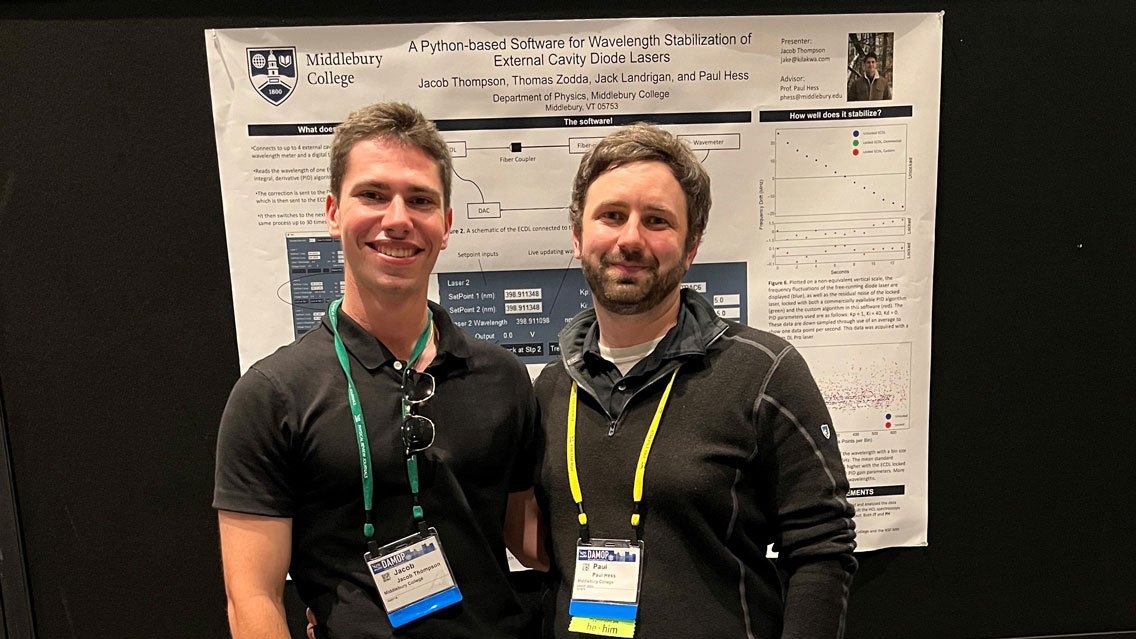Student and Faculty Research
Members of the Physics Department maintain active research programs in observational astronomy, particle physics, quantum computing, experimental condensed matter physics, astrophysics, and biomedical optics.
Students obtain research experience through credit-bearing projects during the school year and through paid internships during the summer months. For some students, research evolves into the senior project required of all physics majors.
Many student-faculty research collaborations culminate in a journal publication, a conference presentation, or a presentation at the Student Research Symposium in April. Students interested in learning more about the research opportunities in physics and astronomy at Middlebury should consult the physics faculty research below as well as our Physics Summer Opportunities site at go/physicssummer. The common application for on-campus summer research in physics can be found here.
Faculty Research
Members of the Department of Physics at Middlebury College maintain active research programs in the areas described below.
Prof. McKinley Brumback
Astrophysics Lab: Prof. Brumback’s research explores the strongest magnetic fields in the Universe, which are found around neutron stars. When neutron stars form in binaries where the gas from a companion star interacts with the ultra-strong magnetic field, it is possible to investigate the magnetic properties of neutron stars and the effect of these extreme environments on matter. Prof. Brumback uses data from X-ray observatories to study the shape and movement of gas within the magnetic fields of neutron stars. Research Website
Prof. Michael E. Durst
Biomedical Optics Lab: Prof. Durst uses nonlinear optics and biomedical imaging to look deep through biological tissue without making an incision. Ultrafast pulsed lasers penetrate scattering samples and create high resolution three-dimensional images through multiphoton microscopy, temporal focusing, and photothermal imaging. Research Website
Prof. Eilat Glikman
Astrophysics Lab: Prof. Glikman studies quasars and their role in the formation and evolution of galaxies. Prof. Glikman’s focus is on dust-reddened quasars, an elusive population that represents a transitional phase in the evolution of active galaxies. Prof. Glikman also studies quasars at high redshifts to understand black hole growth in the early universe. Research Website
Prof. Anne Goodsell
Cold Atomic Physics Lab: Prof. Goodsell studies cold atoms in magneto-optical traps, where the resonant interaction between light and individual atoms in a gas make the atoms stop in midair. Prof. Goodsell and students working with her are preparing to study how cold atoms are influenced by external electric fields. Prof. Goodsell also plans to investigate the forces that affect atoms or ions near solid surfaces. Research Website
Prof. Noah Graham
Theoretical and Computational Physics: Prof. Graham’s research focuses on Casimir forces, which arise from quantum-mechanical fluctuations of charges and fields at distance scales relevant to nanotechnology. He is also interested in applications of high-performance computing, drawing on his experience in the software industry as a research scientist at Dragon Systems (now part of Nuance Communications). Research Website
Prof. Chris Herdman
Computational Quantum Matter and Information: Prof. Herdman studies the quantum mechanical properties of matter and information using computational and theoretical methods. At very low temperatures, quantum effects can transform ordinary matter into a quantum phase of matter, such as a superfluid. Prof. Herdman’s current research investigates how nonclassical phenomena like quantum entanglement arise in quantum matter. Additionally, he studies how such quantum many-body systems might be used in a quantum computer. To these ends, Prof. Herdman develops and implements novel numerical algorithms and takes advantage of high-performance computing resources.
Prof. Paul Hess
Prof. Hess’s research focuses on studying the quantum mechanical properties of tiny crystals made of a few atomic or molecular ions, which are assembled, trapped, and levitated in a vacuum chamber using electric forces. By imaging and manipulating these trapped ions with laser light, he studies their usefulness as the building blocks of a future quantum computer. Student projects might include testing new optical systems for these ion traps, or simulating their behavior on a computer. Opportunities exist for summer research with Prof. Hess and his collaborators in the Trapped Ion Quantum Information group at the University of Maryland. Research Website
Prof. Susan Watson
Prof. Watson studies quantum mechanics, quantum computing, and condensed matter physics. Using carbon nanotubes and semiconductor heterostructures, we investigate quantum bits (qubits), the fundamental building blocks of quantum computation.
Faculty and Student Collaborations
Examples of papers published in peer-reviewed journals and co-authored with students:
- Glikman E., *Langgin R., *Johnstone M. A., Yoon I., Comerford J. M., Simmons B. D., Stacey H., et al., 2023, A Candidate Dual QSO at Cosmic Noon, The Astrophysical Journal, 951, 18L. arXiv:2306.00068
- Glikman E., Lacy M., LaMassa S., *Bradley C., Djorgovski S. G., Urrutia T., Gates E. L., et al., 2022, The WISE-2MASS Survey: Red Quasars Into the Radio Quiet Regime, The Astrophysical Journal, 934, 119. arXiv:2204.13745
- M. E. Durst, *S. Yurak, *J. Moscatelli, *I. Linhares, and *R. Vargas, “Remote focusing in a temporal focusing microscope,” OSA Continuum, vol. 4, no. 11, pp. 2757-2770, 2021.
- M. E. Durst, *A. Turcios, *C. Laurence, and *E. Moskovitz, “Dispersion compensation by a liquid lens (DisCoBALL),” Applied Optics, Vol. 58, Iss. 2, pp. 428-435, 2019.
- Glikman E., Lacy M., LaMassa S., Stern D., Djorgovski S. G., Graham M. J., Urrutia T., *Lovdal L., *Crnogorčević M., *Daniels-Koch H., *Hundal C. B., et al., 2018, Luminous WISE-selected Obscured, Unobscured, and Red Quasars in Stripe 82, The Astrophysical Journal, 861, 37. arXiv:1805.06961
- Glikman E., Simmons B., *Mailly M., Schawinski K., Urry C. M., Lacy M., 2015, Major Mergers Host the Most-luminous Red Quasars at z ∼ 2: A Hubble Space Telescope WFC3/IR Study, The Astrophysical Journal, 806, 218. arXiv:1504.02111
- E. N. Blose,* B. Ghimire,* N. Graham, and J. Stratton-Smith,* “Edge Corrections to Electromagnetic Casimir Energies From General-Purpose Mathieu-function Routines,” arXiv:1411.0734, Physical Review A, 91 (2015) 012501.
- Aden Forrow* and Noah Graham, “Variable Phase S-Matrix Calculations for Asymmetric Potentials and Dielectrics,” arXiv:1210.0777, Physical Review A, 86, 062715 (2012).





